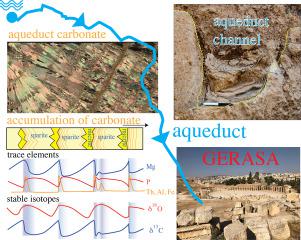当前位置:
X-MOL 学术
›
Palaeogeogr. Palaeoclimatol. Palaeoecol.
›
论文详情
Our official English website, www.x-mol.net, welcomes your
feedback! (Note: you will need to create a separate account there.)
The aqueduct of Gerasa – Intra-annual palaeoenvironmental data from Roman Jordan using carbonate deposits
Palaeogeography, Palaeoclimatology, Palaeoecology ( IF 2.6 ) Pub Date : 2021-01-01 , DOI: 10.1016/j.palaeo.2020.110089 Cees Passchier , Gül Sürmelihindi , David Boyer , Ciğdem Yalçın , Christoph Spötl , Regina Mertz-Kraus
Palaeogeography, Palaeoclimatology, Palaeoecology ( IF 2.6 ) Pub Date : 2021-01-01 , DOI: 10.1016/j.palaeo.2020.110089 Cees Passchier , Gül Sürmelihindi , David Boyer , Ciğdem Yalçın , Christoph Spötl , Regina Mertz-Kraus

|
Abstract Calcium carbonate (CaCO3) deposits from Roman aqueducts are an innovative archive to obtain local high-resolution palaeoenvironmental and archaeological data in interdisciplinary studies. Deposits from one of the aqueducts of the Roman city of Gerasa provide a record of 59 years during the 1st to 3rd centuries CE, divided into three sequences separated by plaster layers. Annual carbonate layers show an alternation of sparite, formed in winter, and micrite, formed in summer. Brown bands at the base of many sparite layers probably correspond to large rainstorms in early winter. A fine lamination present in the brown bands may be diurnal in origin. Stable isotope and trace element data confirm annual layering, indicate strongly variable flow rate in the aqueduct and show truncations that may have been associated with drying up of the channel in some years. The trace element pattern is typical of a relatively small aquifer with a rapid response to precipitation. The trace element composition changes abruptly from the first to the second carbonate sequence, suggesting that a spring was added to increase the flow rate. Deformation twins in calcite crystals at the top of the second sequence may be due to earthquake damage after 48 years of use. The presence of abundant clay in the carbonate sequence, especially in the third sequence, suggests earthquake damage to the channel. The channel was usually replastered after damage. The aqueduct went out of use sometime after the mid-2nd to mid-3rd century CE. The carbonate archive stores key information on groundwater quantity and composition and indirectly on air temperature, rainfall, extreme environmental events and land use at sub-annual resolution.
中文翻译:

Gerasa 的渡槽——来自罗马约旦的使用碳酸盐沉积物的年内古环境数据
摘要 来自罗马渡槽的碳酸钙 (CaCO3) 沉积物是在跨学科研究中获取当地高分辨率古环境和考古数据的创新档案。罗马城市 Gerasa 的一个渡槽的沉积物提供了公元 1 至 3 世纪 59 年的记录,分为三个序列,由石膏层分隔。一年生碳酸盐岩层显示出冬季形成的闪长岩和夏季形成的泥晶岩的交替。许多星体层底部的棕色带可能对应于初冬的大暴雨。棕色带中存在的细纹可能是昼夜出现的。稳定同位素和微量元素数据确认年度分层,表明渡槽中的流速变化很大,并显示可能与几年来渠道干涸有关的截断。微量元素模式是典型的对降水反应迅速的相对较小的含水层。微量元素组成从第一个碳酸盐岩层序到第二个碳酸盐岩层序突然变化,表明添加了弹簧以增加流速。第二层序顶部方解石晶体中的变形孪晶可能是由于使用48年后的地震破坏造成的。在碳酸盐层序中,特别是在第三层序中,存在丰富的粘土,表明该通道受到地震破坏。通道通常在损坏后重新抹灰。渡槽在公元 2 世纪中叶至 3 世纪中叶之后的某个时间停止使用。
更新日期:2021-01-01
中文翻译:

Gerasa 的渡槽——来自罗马约旦的使用碳酸盐沉积物的年内古环境数据
摘要 来自罗马渡槽的碳酸钙 (CaCO3) 沉积物是在跨学科研究中获取当地高分辨率古环境和考古数据的创新档案。罗马城市 Gerasa 的一个渡槽的沉积物提供了公元 1 至 3 世纪 59 年的记录,分为三个序列,由石膏层分隔。一年生碳酸盐岩层显示出冬季形成的闪长岩和夏季形成的泥晶岩的交替。许多星体层底部的棕色带可能对应于初冬的大暴雨。棕色带中存在的细纹可能是昼夜出现的。稳定同位素和微量元素数据确认年度分层,表明渡槽中的流速变化很大,并显示可能与几年来渠道干涸有关的截断。微量元素模式是典型的对降水反应迅速的相对较小的含水层。微量元素组成从第一个碳酸盐岩层序到第二个碳酸盐岩层序突然变化,表明添加了弹簧以增加流速。第二层序顶部方解石晶体中的变形孪晶可能是由于使用48年后的地震破坏造成的。在碳酸盐层序中,特别是在第三层序中,存在丰富的粘土,表明该通道受到地震破坏。通道通常在损坏后重新抹灰。渡槽在公元 2 世纪中叶至 3 世纪中叶之后的某个时间停止使用。











































 京公网安备 11010802027423号
京公网安备 11010802027423号